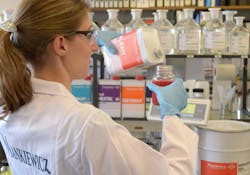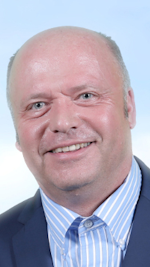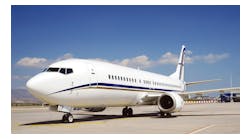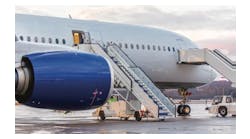Game Over for Germs and Sharks in the Sky
The Germany-based paint specialist, Mankiewicz has delivered paint solutions for aircraft exteriors and interiors for decades. Paint has evolved over the time and is increasingly delivering functions not known before. On the aircraft skin, paint has the task to protect the fuselage and to look pretty; inside the fuselage, paint has to fulfill similarly, but varying functions - all depending on the location. With a new antimicrobial, FST Coating Mankiewicz now has declared a war on germs inside the aircraft. The new antimicrobial paint is a hidden detail which is of increased importance in this globalized - travel - word and is getting the attention of aircraft operators and of passengers. This was the reason for AMT European Correspondent to visit Mankiewicz and a production facility in Hamburg, Germany.
Main reason for the AMT visit is the information that the company is presenting at the upcoming Aircraft Interiors Expo (AIX) in Hamburg (2-4th April) is its antimicrobial FST coating with a demonstration of effectivity in the reduction of bacterial growth.
Bacteria in the Airplane, Is This a Problem?
Let's think about your last airline travel. Do you have an approximate idea of how many people have used the restroom before you went there, on a local flight? No, you probably don't. Let's recap your last transcontinental or transoceanic flight - things now look even worse, don't they? Have you ever thought about how many germs may accumulate on a single flight with more than 100 travelers using (multiple times) each toilet?
Image: "Mank. antimicrobial coatings - results" by Mankiewicz
A Remedy is Available
Well, not many travelers think about this issue but at Mankiewicz specialists worked to find a remedy to this invisible problem. According to Mankiewicz, it is the only supplier which has implemented an antimicrobial coating system for aircraft interiors which at the same time fulfills the stringent FST (fire, smoke, toxicity) demands of the aviation industry, and has a proven long-term effect. The manufacturer claims that the antimicrobial efficacy of the coating is proven in empirical and practical long-term tests.
Not toxic Image: "Mank. antimicrobial coatings - effectiveness" by Mankiewicz
According to the manufacturer, this coating doesn’t have any toxic side effects as it inhibits the growth of the bacteria not by means of chemical (toxic) substances but by use of technology based on natural silver - a natural product - which is chemically not modified and is harmless to humans.
The application and repair of the water-based coating are according to Mankiewicz easy as it consists of a single paint layer which is chemically and mechanically resistant. As the antimicrobial technology is included in a normal topcoat layer the treatment is not adding weight to the aircraft structure. This product is available as a textured or smooth topcoat with a wide color range.
With this antimicrobial coating, the costs of disinfection are reduced - not eliminated - and fewer cleaning cycles are needed. It reduces the smell in toilets but regular cleaning is still required to remove dirt and fat. The antimicrobial coating can be used in all hygiene sensitive areas throughout the entire cabin, not only in lavatories.
This product is according to the manufacturer also conceivable for applications on other parts of the aircraft interior like armrests, folding tables, seats and wall fairings, etc.
Design style and effects are important to airlines, and as they change over time it is useful to mention that this coating can also be used for the BFE (buyer furnished equipment) and for the retrofit market.
Already in Use
This antimicrobial coating is already being used in lavatories by Boeing on the entire 737 aircraft fleet and is an option for Airbus A350 lavatories (Airbus AIMS 04-08-005, B/E LCMS 501 approvals).
Sharks in the Sky
It is a fact that airplanes are every day more sophisticated and their price is not rising accordingly with the technological development, mainly because the airlines are under tremendous cost pressure. This situation is aggravated by the fact that customers and the industry have understood that it is essential to reduce the carbon footprint whenever possible.
In the aviation industry, there are many ways of reducing costs and the carbon footprint. This is achievable with lighter airframes, more efficient turbines, and more efficient aerodynamic properties of aircraft. Savings in the field of aerodynamics translate almost directly into fuel savings and better performance.
From the very beginning, designers tried to improve airflow around the fuselage and the wings. Improvements of the boundary layer airflow are especially delicate on the wings where slight improvements usually result in huge benefits. The reverse side of the medal is that improvements of the wings aerodynamic properties are a difficult, long, and delicate process. For decades airflow specialists have tried to improve the flow of the air around aircraft trying to reduce drag by channeling the air along the body of the aircraft. What sounds easy, is, in reality, difficult and many projects failed because the transfer process from ideas and calculations to real airplanes didn't work too well in everyday use.
Recently, the bionic design - implementation of solutions learned from nature - gave an additional push to aerodynamic design research improvements. So it came as no surprise when Airbus selected Mankiewicz, amongst others, as a partner for the development of a highly functional sharkskin paint.
Learning from Nature
Sharks are successful hunters, and they are fast - faster than a prayer. One thing that makes them so fast is their special skin which consists of many riblets. Riblets are microscopic, µm thin, longitudinal ribs on the shark scales which optimize sharks' swim (flow) resistance. The shark riblets impede turbulence creation transversal to flow direction of the water, which minimizes resistance. Something similar, but with a different medium, air instead of liquid, may bring huge benefits to aircraft.
Image: "REM_2.jpg" by Mankiewicz
The long-term trial carried out within the frame of European Union research project "Clean Sky" tried to transfer known biological structures into technical processes and, finally to aircraft surface, in this case, to paint. In the research project "Multifunctional Coatings," which started in Summer 2011, Mankiewicz, Airbus, Lufthansa, the German Fraunhofer lnstitut für Fertigungstechnik und Angewandte Materialforschung (IFAM) and other project partners have entered a cooperation to study the resistance of these surfaces in-flight.
Two areas on a conventional aircraft wing were coated with a new paint and tests were performed in flight. In focus of interest were the resistance of new structures (e.g. environmental impact) and the longevity of the product and its price/benefit relation.
A Micro-Structured Paint Film as a Solution
Mankiewicz engineers developed a specific UV-curing paint system with a very small content of a volatile solvent which complies with the aviation industry requirements. For this purpose the new paint system is dirt-repellent, UV-stable, and extremely resistant to abrasions and erosion. A new method was developed for application of the micro-structure paint: The riblet micro-structure is minutely transferred onto the paint by "simultaneous stamping and curing." The paint is applied by means of a silicon sheet carrying a negative of the riblet structure and is immediately UV-cured. Thereafter, the silicon sheet is removed. The results of the ongoing tests were very promising, so much so that the project partners have decided to continue. There is a challenge to find an effective way of coating something as huge and complex as an airplane.
The final target is an accurate, fast, and efficient process which will allow painting of relevant parts of the aircraft with this sharkskin effect paint. Current calculations predict over 1 percent of fuel savings. The painting process is now being further optimized and new application techniques are in the final stage of development and the project partners have apparently found a way how to economically and profitably apply the sharkskin paint on large aircraft surfaces.





